The low thermal conductivity of wood makes it possible to make walls of small thickness. Together with the lightness of the building material itself, this causes a lower load on the base compared to brick or concrete buildings. Nevertheless, the foundation for a log house must be selected and designed carefully, otherwise errors may result in its deformation, followed by unsuitability for use.
Choosing a base for a log house
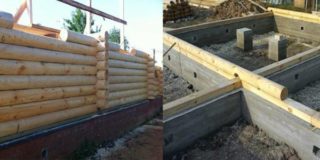
When determining which foundation is best for a log house, they rely on the characteristics of the local soil - the composition, the level of occurrence of the waters, the features of the relief. In addition, the mass of the building, the load acting on the base, and the layout of the house are taken into account.
Tape
This structure looks like a strip of reinforced concrete on which the walls are being erected. The level of deepening is chosen depending on the construction conditions: on uncomfortable soils, during the construction of a two-story building or in the presence of a basement in the project, the base is made low. A strip foundation made of logs from which the walls are made cannot be performed. For its arrangement, formwork from boards and concrete mortar are needed for pouring. To make the foundation more reliable, a reinforcing cage is organized for it. Such a structure has a good load-bearing capacity, so that houses from heavier materials (brick and stone) can be erected on it.
Columnar
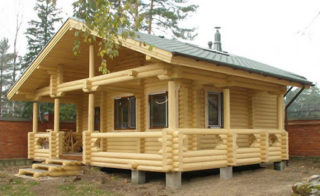
Such a foundation for a log house attracts with a budget price. However, it will not work to equip the basement floor when using it, moreover, this type of base is picky about the quality of the soil. It is suitable for the construction of light buildings (baths, sheds, small one-story wooden houses) on sandy soils that are not characterized by high humidity or high groundwater levels.
To combine the pillars into a single structure, they are tied with a grillage tape. Such a foundation is more reliable than one consisting only of point supports, but it will take more resources for it. You can organize a foundation of logs that will serve as pillars. At the same time, it is important to carefully consider the quality of lumber and their treatment with antiseptics and compounds that protect against moisture. Old or sharpened logs cannot be used for this purpose.
A log house on a slab foundation is of interest due to the fact that it allows you to erect a building even on problem, heaving soils. The construction of a log house on a monolithic slab is permissible, but usually not practiced due to the disproportionate cost of resources: a lot of concrete is spent on pouring the base, for a light house you can do less without losing reliability.
Prefabricated foundations from blocks are used more often. Hollow floor slabs should have a thickness of 2.2-2.5 m.If it is decided to make the base monolithic, this parameter takes values of 0.3-0.35 m.
Features of the implementation of various supports
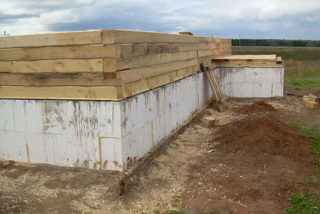
Before you start equipping the foundation for a 6x6 log house or other sizes, you need to choose the appropriate version. After that, calculations are made and the necessary building materials are purchased.
Tape
If the soil has a high moisture content, a buried base is preferred. It is also suitable for high-rise groundwater. In this case, the laying is carried out 0.3 m below the soil freezing mark. Such a base allows you to equip a basement with good protection from soil moisture.
A shallow tape is well suited for the foundation under a log house. When choosing it, the soil must be pre-insulated so that it does not freeze. The depth of the filling will be 0.6 m.When building a bath, this value can be reduced by 0.1-0.2 m.
Columnar
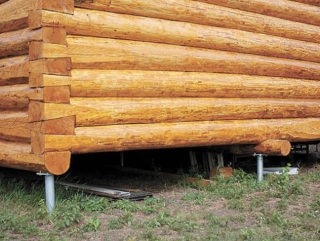
Support pillars are placed in the corners of the future building and in other areas where a high load is created (for example, load-bearing walls). The distance between them is about 2 m. If wooden supports are used, they must be immersed to the freezing point of the soil. Rounded logs and glued beams are well suited for this purpose. The cross-section of the pillars can be circular or quadrangular.
Ground piles are used on problem soils. Although they are quite expensive, they provide maximum reliability when used in areas where there is a tendency to heaving, waterlogging or increased soil mobility. When deepening the pile, its end must rest on solid ground.
Before starting work, the surface layers of the soil are removed to the desired depth. After that, they equip a sand cushion - this helps to reduce the load associated with seasonal heaving. Then they begin to mount the foundation under the log house. It is advisable to organize a bundle of pillars with a grillage - then the base will be stronger, but this is not required for a bathhouse or outbuilding.
Earthwork for the manufacture and execution of markings
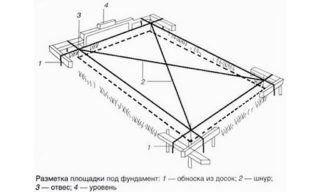
First you need to remove the vegetation layer and mark the site. It should be level and have a slight slope to drain rainwater, which would otherwise accumulate and destroy the base. Reinforcement rods and strong fishing line are used for marking. The most accurate results of the procedure will be if you use a laser level. The cast-off should be located 1.5-2 m from the front. In the process of marking, it is necessary to check that all corners of the building are straight.
When the outer and inner boundaries are marked, proceed to digging a trench. If a basement is planned in the house, a foundation pit is arranged instead. Otherwise, this is not necessary. Depth is measured from the highest point of the site. The water level will help determine it. With its help, you can level the bottom. For the construction of a small log house, the depth will be 0.55-0.65 m, of which 0.1-0.15 m falls on the sand cushion. The latter is poured in portions, after each part, tamping and leveling.
A formwork of edged boards is mounted, which sets the boundaries of the concrete base and determines its shape. The end sections are fastened with self-tapping nails - this reduces the likelihood of the mixture seeping out. The sides and tops are reinforced with struts. The internal parts, which will be in contact with concrete, are lined with roofing material. Using a welding machine, a rigid frame is formed from one-piece reinforcement. The base is poured gradually, carefully ramming each portion with a vibrator.
You can start building a log house 3 weeks after the end of the work. At this time, the foundation should be covered with polyethylene, so that the mixture is not washed away by rain.
Existing standards for the construction of a foundation for a log house
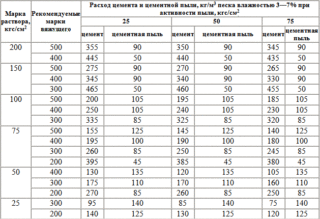
All wood materials used in the work must be treated with antiseptics and compounds that protect against moisture. You should also adhere to the following rules:
- do not allow excess water in the mixture (permissible maximum - 60%, for wet sand - 50%);
- if it is cold outside, the water for the solution is preheated (this way the foundation will harden faster), and in the summer, on the contrary, they use cold water;
- there should be twice as much gravel in the mixture as sand.
The waterproofing material is laid in 2-3 layers. A polyethylene film is a good choice for covering the pillow.








